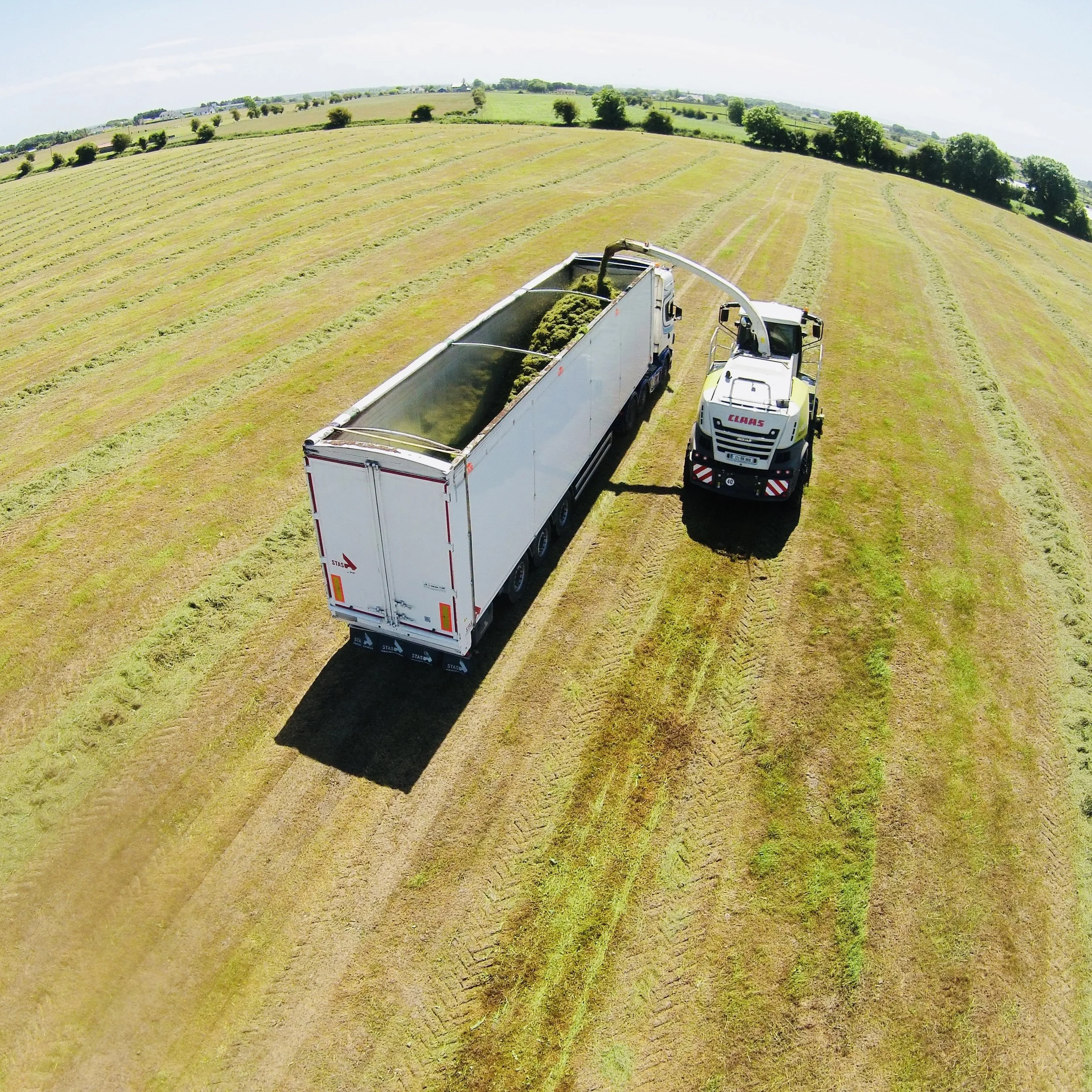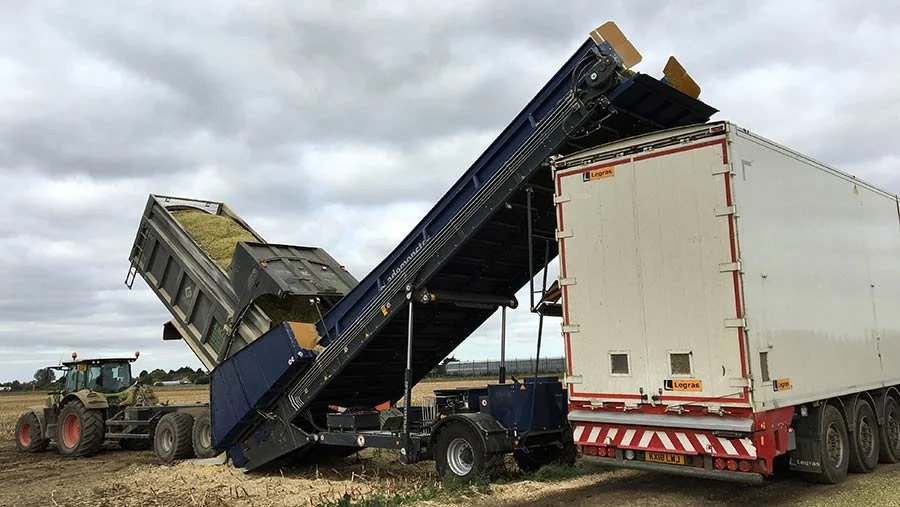Should you be moving silage by lorry?
Silage making is a materials processing problem crossed with a logistics nightmare and a microbiological juggling act - or something like that. I’ve looked at some of the other aspects in detail, but what about the logistics issues?
The logistics of moving silage.
We move stuff further today than we have ever done. A huge amount of the stuff we consume is produced on the other side of the globe. Some people (most people?) think nothing of a weekend break in another country a thousand miles from home. And we also give little thought to hauling silage far far greater distances than our grand parents would ever consider. Bigger trailers, better brakes and fast tractors make it all seem a bit more do-able. But when does the distance become so great that you might consider a truck over a tractor?
Truck or silage trailer?
There comes a tipping point (or should that be distance) where a truck becomes a more economical solution than a tractor and trailer. Every situation is different of course, but there will be a point where it makes sense to load a lorry rather than sticking with tractors and trailers. The truck itself is always going to be more expensive because it runs on normal pump diesel and pays a huge amount of road tax. Its driver also has limited driving hours too because of the tachograph laws, but because the truck can run at 44t gross weight rather than the 31t of a tractor and trailer, the driver does move more tonnes per hour.
That truck might have something close to a 30t payload of silage in the trailer where your tractor can only legally be moving around 16t in the UK, and at a lower speed too. An HGV on single carriageway (A and B) roads in the UK is limited to 80kph or 50mph. Your 50k tractor is limited to 40kph or 25mph in most situations on the highway although some tractors are permitted to 65kph (JCB Fastrac for example).
So in an hour a truck driver can theoretically move 2400tk (tonne kilometres) whilst she/he can only move 720tk sat on a tractor. Even if you ignore the 40k limit (everyone else does) then the tractor still moves less than 1000tk travelling at 55k. So lorries might not be quite so unattractive after all.
Are the tractors days numbered?
Now you might be sitting there with a calculator working out the cost per tonne moved and still thinking that the tractor and trailer is coming in cheaper in your situation. And that might well be the case but you should also be prepared for change. This is because the current agricultural rules and regulations around transport and silage are (whisper it quietly) a bit out of date. These regulations didn’t really anticipate anyone storing 10,000 tonnes of silage in a single facility or drawing forage from 50 miles away from home.
Specialist silage trailers from Krone
There will come a point in time where they won’t allow a tractor and trailer piloted by an 18 year old student to be chosen over a truck. The loss in revenue to the exchequer in road tax, fuel duty and MOT checks alone is enough to tempt the government into legislative change. All it needs is for one tragic accident to hit the news and “there will be calls form all sides of the house” for more legislation and restriction on agricultural transport.
Is Anaerobic Digestion still an agricultural operation?
If you’re making gas or electricity are you still farming or are you now a power company? Well the legal definition of agriculture is complicated because it’s not all about food production. It is an agricultural use if the land produces at least an annual crop be that grain or vegetables for human consumption, or feed for livestock, or other crops such as tobacco or a biomass energy crop.
So as it stands today, operations that are being carried out on land that is growing energy crops are agricultural operations and, as such, can be carried out with machines fuelled by duty free (red or green) diesel. The road journeys to allow these operations to be carried out can also be fuelled on duty free diesel.
That sounds a bit legalistic, so in simple terms you can run on red to cart silage to an AD plant - currently. So a tractor might be still be cheaper in some situations but if you really want to get into trucks, just how are you going to get the silage into the bulkers?
Loading silage into bulk haulage trucks
In the dry parts of the world you might be familiar with lorries running along side the harvester in the field. That’s unlikely to be happening in the UK too often because the ground conditions just don’t allow it. It may be possible for some crops like whole crops such as rye because they are harvested in the summer, but for maize being cut in October it’s not going to be practical. So how do you get silage into a lorry without wasting a huge amount of crop?
Tipping onto a field heap that is reloaded with a shovel or 360 excavator is the simplest solution but there are lots of problems. You can expect some significant physical losses, maybe 5% in good conditions, but there are some additions that you might not want too. Soil contamination is really not good for fermentation and leads to all sorts of problems with in-clamp losses. Then there are the stones too - you really really don’t want those - whatever you are feeding silage to. Using a mobile loading system such as a ROPA Maus might work for you, if you can find one - but I’ve only ever seen one loading silage on Youtube so I’m not in a position to comment on the benefits.
Loading silage into lorries with a CLAAS Torion
So what other options are there to load trucks with silage?
The best solution is to move the tipping point to some hardstanding and continue with the loading shovel. It’s worth scouring the area and asking some questions of local land owners because this is really the cheapest overall solution. But if that’s not going to work then maybe another sort of transfer solution is needed. HAWE make a range of silage trailers with a blower and chute built into the front that are designed to blow the forage into a truck just as if it were coming straight off the chopper. These machines claim to deliver silage at a similar rate to a 1000hp chopper so maybe three units could keep the harvester moving without interruption.
HAWE silage transfer trailers in action
An alternative solution is offered by Fliegl using a conveyor rather than a blower. Their trailers can be fitted with an upward angled conveyor in place of the back door. Positioning to trans-ship the load is a bit more complex compared to the Hawe and the lorry needs to move along to “load” the silage, so it probably needs a banksman to choreograph the movements. To offset this the Fliegl system has a much quicker transfer rate so it’s probably swings and roundabouts between the two systems.
Fliegl silage trailer with transfer option
Then there is always the simple dump box and tractor driven blower more commonly seen filling tower silos in North America. In Europe it’s more common to use a conveyor elevator such as the Becklonne Lademonster. This type of machine offers a pretty simple solution at minimal capital cost and might be the best answer if you can’t get access to a concrete yard. What it can’t offer is any sort of buffer capacity to enable trailers to empty if the trucks don’t turn up when you need them. That’s the problem with anything other than a heap in reality.
Loading silage into trucks with a Becklonne Lademonster
Even if you’re not looking to move to truck transport tomorrow, it might be something you need to start to think about. It is likely that one day the tractor and trailer might not be the answer to your silage logistics either due to legislation or distances.
If you want to discuss how to transport your silage to the clamp or would like to discuss any other aspects covered in this series, contact me at jeremy@silageconsultant.co.uk





